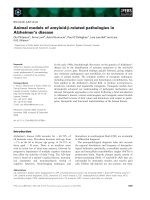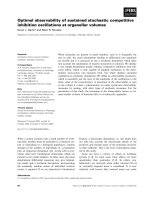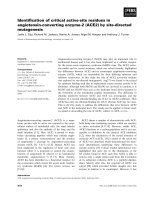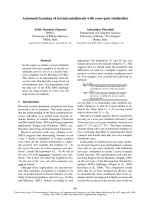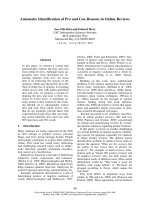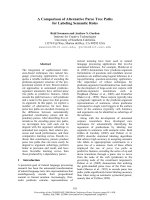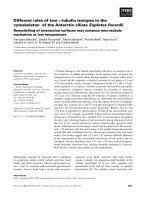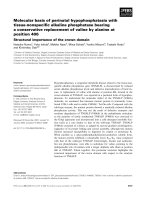Báo cáo khoa học: Intermonomer cross-linking of F-actin alters the dynamics of its interaction with H-meromyosin in the weak-binding state ppt
Bạn đang xem bản rút gọn của tài liệu. Xem và tải ngay bản đầy đủ của tài liệu tại đây (370.68 KB, 10 trang )
Intermonomer cross-linking of F-actin alters the dynamics
of its interaction with H-meromyosin in the weak-binding
state
Gyo
¨
rgy Hegyi
1
and Jo
´
zsef Bela
´
gyi
2
1 Department of Biochemistry, Eo
¨
tvo
¨
s University, Budapest, Hungary
2 Institute of Bioanalysis, University of Pe
´
cs, Hungary
The molecular motions of actomyosin, most notably
those underlying muscle contraction, result from
dynamic interactions between actin and myosin as
driven by ATP hydrolysis. Within the force-producing
cycle, the myosin head undergoes profound conforma-
tional changes. A detailed picture of the movements
Keywords
actin cross-linking; actomyosin interactions;
EPR spectroscopy; heavy meromyosin
Correspondence
G. Hegyi, Department of Biochemistry,
Eo
¨
tvo
¨
s University, Pa
´
zma
´
ny Pe
´
ter se
´
ta
´
ny
1. ⁄ C H-1117 Budapest, Hungary
E-mail:
(Received 3 January 2006, revised 20 Febru-
ary 2006, accepted 22 February 2006)
doi:10.1111/j.1742-4658.2006.05197.x
Previous cross-linking studies [Kim E, Bobkova E, Hegyi G, Muhlrad A &
Reisler E (2002) Biochemistry 41, 86–93] have shown that site-specific
cross-linking among F-actin monomers inhibits the motion and force
generation of actomyosin. However, it does not change the steady-state
ATPase parameters of actomyosin. These apparently contradictory findings
have been attributed to the uncoupling of force generation from other pro-
cesses of actomyosin interaction as a consequence of reduced flexibility at
the interface between actin subdomains-1 and -2. In this study, we use
EPR spectroscopy to investigate the effects of cross-linking constituent
monomers upon the molecular dynamics of the F-actin complex. We show
that cross-linking reduces the rotational mobility of an attached probe. It
is consistent with the filaments becoming more rigid. Addition of heavy
meromyosin (HMM) to the cross-linked filaments further restricts the rota-
tional mobility of the probe. The effect of HMM on the actin filaments is
highly cooperative: even a 1 : 10 molar ratio of HMM to actin strongly
restricts the dynamics of the filaments. More interesting results are
obtained when nucleotides are also added. In the presence of HMM and
ADP, similar strongly reduced mobility of the probe was found than in
a rigor state. In the presence of adenosine 5¢[bc-imido] triphosphate
(AMPPNP), a nonhydrolyzable analogue of ATP, weak binding of HMM
to either cross-linked or native F-actin increases probe mobility. By con-
trast, weak binding by the HMM ⁄ ADP ⁄ AlF
4
complex has different effects
upon the two systems. This protein–nucleotide complex increases probe
mobility in native actin filaments, as does HMM + AMPPNP. However,
its addition to cross-linked filaments leaves probe mobility as constrained
as in the rigor state. These findings suggest that the dynamic change upon
weak binding by HMM⁄ ADP ⁄ AlF
4
which is inhibited by cross-linking
is essential to the proper mechanical behaviour of the filaments during
movement.
Abbreviations
ABP, N-(4-azidobenzoyl) putrescine; AMPPNP, adenosine 5¢[bc-imido] triphosphate; ANP, N-(4azido-2-nitrophenyl) putrescine; CW EPR,
conventional EPR; HMM, heavy meromyosin; maleimido-TEMPO, 4-maleimido-2,2,6,6-tetramethyl-1piperidinyloxy free radical; p-PDM,
N,N¢-p-phenylenedimaleimide; S1, myosin subfragment-1; ST EPR, saturation transfer EPR.
1896 FEBS Journal 273 (2006) 1896–1905 ª 2006 The Authors Journal compilation ª 2006 FEBS
within the myosin head has been inferred from X-ray
crystallographic data of myosin subfragment-1 (S1)
crystallized in the presence of different ATP and
ADP ⁄ P
i
analogues, as well as from kinetic studies
using site-specific reporter signal probes [1,2]. Other
studies have shown structural and dynamic changes of
actin filaments due to their interaction with myosin.
Less well understood, however, is the nature of con-
formational changes that occur within the filament
during force generation. On the basis of polarized–
fluorescence measurement of ghost fibres labelled with
e-ATP, it was shown that both the elastic modulus of
the filaments and the orientation of actin monomers
change upon the addition of heavy meromyosin
(HMM) [3]. In another study, glycerinated actin fibres
labelled with fluorescent phalloidin were analysed by
fluorescence–polarization spectroscopy. The develop-
ment of isometric tension was accompanied by a small
rotation of the constituent monomers within each actin
filament [4].
Recent studies using polarization–fluorescence
spectroscopy indicate that dye molecules attached to
actin change their orientation and mobility during the
course of actomyosin ATPase cycles. The weak versus
strong binding of the myosin S1 domain to labelled
actin filaments causes opposing changes in polarization
parameters. Apparently, subdomain movement occurs
during the transition between weak- and strong-bind-
ing states [5].
EPR studies of probes attached to actin filaments
have shown internal rotation occurring on a micro-
second timescale. The binding of myosin heads exerts
a co-operative effect that further restricts rotational
motion within the actin filaments [6–8]. Moreover,
experiments using caged ATP show no evidence for a
difference between weak- and strong-binding states [8].
Measurements made by anisotropy of fluorescence
using a narrow-aperture confocal microscope yield
contrary results: changes in actin orientation during
the power stroke were found [9], furthermore fluores-
cence–polarization measurement of sliding filaments in
an in vitro motility assay led to the conclusion that the
sliding F-actin performs an axial rotation with one
revolution per 1 lm sliding distance [10].
It would be particularly interesting to find that con-
straints upon the flexibility of actin filaments affect
their functional properties. In this respect, cross-link-
ing studies are relevant, as they provide detailed infor-
mation on the relationship between the structure and
dynamics of actin and its motility. Three site-specific
cross-links are localized in actin filaments. Cross-links
connect Gln41 to Lys119 [11] and Gln41 to Cys374
[12] among actin molecules within the same strand,
and another cross-link between Cys374 to Lys191 [13]
connects opposing strands in the actin filaments. All
three cross-links similarly inhibit filament sliding speed
and force generation in in vitro motility assays. By the
same token, none changes the strong binding of myo-
sin S1 to actin, nor do they alter the V
max
and K
M
parameters of actomyosin ATPase activity or the rates
of ADP release from acto-S1 [14,15]. One interpret-
ation is that constrained dynamic flexibility within fila-
ments causes an uncoupling between force generation
and other molecular processes of actomyosin interac-
tion. We addressed this issue using EPR spectroscopy
to follow the dynamics of cross-linked actin filaments
and to examine the effect of HMM binding. The spin-
labelled probe was 4-maleimido-2,2,6,6-tetramethyl-
1piperidinyloxy free radical (maleimido-TEMPO)
covalently attached to Cys374. The primary aim of the
study was to find differences in the dynamics of the
constituent actin molecules of cross-linked versus
native filaments. We hope that the resulting data will
give clues to the mechanism by which cross-linking
decreases movement in the in vitro motility assay.
Results and Discussion
Rotational motion of spin labels in cross-linked
actin filaments
It is known from earlier experiments that Cys374
incorporates > 90% of the labels under the conditions
used in this study, proving that the labelling procedure
was highly selective [6,7,16]. Both conventional
(CW EPR) and saturation transfer EPR (ST EPR)
measurements showed that the labels were rigidly
attached to actin monomers, and indicated the motion
of a larger domain in the monomer. According to our
experiments, in F-form uncross-linked actin the hyper-
fine splitting constant 2A¢
zz
, which depends upon the
slow rotational motion of the attached label, was
6.835 ± 0.026 mT (n ¼ 8), whereas the diagnostic
ST EPR parameter L¢¢ ⁄ L was estimated to be
0.7 ± 0.1 (n ¼ 4), which corresponds to a rotational
correlation time of 50–60 ls. Very likely, the labels
reflected the torsional motion of several associated
subunits.
The cross-links between the monomers by bifunc-
tional reagents in F-actin imposed constrains on the
structure, which influenced the internal motion of the
protein (Fig. 1). Both inter- and intrastrand cross-links
significantly affected the rotational motion of labels as
measured by ST EPR. The intrastrand cross-links
Gln41–Cys374 and Gln41–Lys113 seemed to produce
a significantly larger decrease in the mobility of the
G. Hegyi and J. Bela
´
gyi Cross-linking affects the dynamics of F-actin
FEBS Journal 273 (2006) 1896–1905 ª 2006 The Authors Journal compilation ª 2006 FEBS 1897
labels than the interstrand cross-links Lys191–Cys374,
which evoked only a moderate change. Information
regarding the localization of the three cross-links
within the actin filaments in either the same or the
opposing strand has been published previously
[12,13,15]. Here, for clarity, the position of the EPR
reporter group and one type of cross-link in the used
copolymer is depicted in Fig. 2.
Decreases in the rotational motion of the labels sug-
gest an overall restriction of the flexibility in cross-
linked filaments. In the copolymers, subdomain 1,
where the spin probe is attached, is not directly
involved in the intermonomer cross-link, because one
of the cross-linking sites is occupied by the spin probe,
therefore, the rigidity of the cross-links between neigh-
bouring monomers may affect the changes in the
motion of the probes. The estimated ratio of cross-
linked to uncross-linked interfaces is 1.5 : 1, based
on the composition of the copolymers (see Experimen-
tal procedures) and SDS ⁄ PAGE analysis of the effi-
ciency of the cross-linking reaction. In addition to the
change in the dynamics of the filaments, some torsion
A
B
a
LL"
b
c
H
Fig. 1. ST EPR spectra of F-actin in native (A) and cross-linked (B)
filaments. To generate such filaments, covalent attachment of
the spin label to residue Cys374 of actin and cross-linking within ⁄
between protein subunits were accomplished as described in
Experimental procedures. Each sample was contained in a flat cell
oriented parallel to the magnetic field vector H. This geometry
minimized distortion of the signal due to incomplete alignment of
F-actin filaments. (B) shows the spectra of filaments of F-actin with
three sorts of cross-links: (a) interstrand cross-links from Cys374 to
Lys191; (b) intrastrand cross-links from Gln41 to Lys113; (c) intra-
strand cross-links from Gln41 to Cys374.
Fig. 2. Copolymer of Cys374 ⁄ maleimido-TEMPO labelled and
Gln41–Cys374 cross-linked actin. A segment of actin filament built
up from six monomers is shown with different colours using PDB
1MVW data. Yellow and red spheres are assigned Cys374 and
Gln41, respectively. Black lines show cross-links between Gln41
and Cys374 residues located on neighbouring monomers in the
same actin strand. Black spheres symbolize the EPR probe
attached to the Cys374 residue. Cross-linked and EPR probe
labelled sites distribute randomly within the filaments, the estima-
ted ratio of cross-linked and uncross-linked interfaces is about
1.5 : 1.
Cross-linking affects the dynamics of F-actin G. Hegyi and J. Bela
´
gyi
1898 FEBS Journal 273 (2006) 1896–1905 ª 2006 The Authors Journal compilation ª 2006 FEBS
in the geometry at the interfaces of the cross-linked
monomers cannot be excluded. However, earlier stud-
ies have shown no significant distortion in F-actin
structure in the case of Gln41–Cys374 [14,15] and
Lys191–Cys374 cross-links [13], but on the basis of
the positive cooperation of the cross-link formation
between Gln41 and Lys113 some structural change
was considered [15]. For this reason, we did not per-
form a detailed investigation of the interaction between
myosin fragments and actin filaments cross-linked
between Gln41 and Lys113.
Orientation dependence of EPR spectra of
cross-linked actin
Actin filaments prepared using various techniques self-
assemble into an ordered structure. The resulting
geometry of spin-labelled actin is expected to influence
the EPR spectrum. Oriented actin filaments can be pre-
pared by flow through a capillary tube, by diffusion of
actin monomers into muscle fibres or by careful smear-
ing of an actin pellet onto the surface of a Zeiss flat cell
[17,18]. Electron microscopy observations confirm that
the last method produces well-oriented actin filaments.
Two populations of probe molecules are detected in
such an oriented system, one is highly ordered and the
other relatively disordered [8,18,19]. Analysis of EPR
spectra allowed derivation of the orientation distribu-
tion of spin labels, where the z-axis of the molecular
reference system fits a Gaussian distribution [8]. Our
analysis on experimental spectra showed that the angle
between the principal z-axis of the spin label and the
filament long axis was 34 (±3)° with a full width of
23° at half maximum of the distribution (Fig. 3). The
second population of spin labels that was relatively dis-
ordered had a mean angle of 63 (±5)° with a full width
at half maximum of 43°. For the sake of comparison,
actin pellets were prepared from different samples, and
EPR spectra were recorded on partially oriented gels in
the Zeiss flat cells (Fig. 4). By rotating the flat cell, the
filament long axis (k) is oriented either parallel (H par.
k) or perpendicular (H per. k) to the laboratory
magnetic field, and the ratio of the hyperfine splitting
constants is compared (Table 1). The ratio of the hy-
perfine splitting constants can be used as a simple order
parameter for comparison of different samples, because
this ratio reflects the change in the angular distribution
of the attached labels. In the case of a random distribu-
tion of probe molecules this ratio is equal to one. The
intrastrand cross-links produce a significantly larger
change in the orientation of the attached probe mole-
cules than do interstrand cross-links. In all three cases,
the locations of the probe molecules are relatively far
from the spatial localization of the cross-links, but the
imposed constraints affect the orientation of the probe
molecules. The disorder can arise either from disorder
of a local region of the protein or from improper orien-
tation of the filaments. X-Ray diffraction experiments
led to the conclusion that the disordered component
might arise from disorder within an ordered filament
[19].
Effects of cross-linking on the interaction of actin
and myosin fragments
It is known that the addition of small amounts of
HMM to actin filaments immobilizes the probe within
a rigor complex. The hyperfine splitting constant peaks
at a molar ration of 0.2 HMM ⁄ actin, then decreases
2A′
zz
H
Fig. 3. Conventional EPR spectra of native F-actin filaments. A gel
of this protein was applied to the surface of a flat spectroscopy
cell. EPR spectra were recorded with this surface of the cell orien-
ted parallel (upper) or perpendicular (lower) to H. The signal from
the latter sample was corrected; the population arising from inexact
alignment among F-actin filaments was subtracted. The resulting
spectrum reveals the distribution of orientations among the
attached spin labels. The quantity 2A’
zz
, the hyperfine splitting con-
stant, is indicated on the magnetic field-axis.
G. Hegyi and J. Bela
´
gyi Cross-linking affects the dynamics of F-actin
FEBS Journal 273 (2006) 1896–1905 ª 2006 The Authors Journal compilation ª 2006 FEBS 1899
upon the addition of more HMM. Presumably, the
extra HMM shields the probe bound to actin residue
Cys374 [6]. Cross-linking within filaments does not
fundamentally alter this phenomenon. Because the pro-
tein (and its attached probe) are further immobilized
by both Gln41–Cys374 and Gln41–Lys113 intra-
strand cross-links, the hyperfine splitting constants do
increase, an effect observed at all concentrations of
added HMM.
To further study the flexibility of the filaments, the
mobility of the paramagnetic probe attached rigidly to
the filaments was determined at different temperatures
(Fig. 5). The Arrhenius principle predicts an inverse
dependence of the hyperfine splitting constant upon
temperature, a consequence of intramolecular thermal
motions. Deviation from a linear dependence could
occur when effect other than temperature increase pro-
duce changes in the conformation of interacting pro-
teins within the same temperature range. Indeed, the
hyperfine splitting constant decreases as the tempera-
ture is increased, an effect common to native and
cross-linked F-actin. Cross-linking is observed to
restrict the mobility of the filaments at all tempera-
tures. In order to explain the linear dependence of
[2A¢
zz
(0 °C) ) 2A¢
zz
(t °C)] upon 1000 ⁄ T, we assume
that 2A¢
zz
(0 °C) is approximately equal to the rigid
limit of the hyperfine splitting constant, 2A
r
zz
. The
rotational correlation time for the bound spin label
follows from the Goldman equation [20]. According
to the logarithmic formulation thereof, we find that
ln s
2
¼ b⁄2A
r
zz
*[2A¢
zz
(0 °C) ) 2A¢
zz
(t °C)] + (ln a ) b).
This mathematical relationship is a formal state-
ment of the proportionality between ln s
2
and the dif-
ference between hyperfine coupling constants. This
A
B
a
b
c
2A′
zz
H
Fig. 4. Conventional EPR spectra of native and cross-linked F-actin
filaments as determined in Fig. 3. The spectrum in (A) was recorded
in a cell oriented parallel to H. The spectra in (B) were recorded
when the cell is oriented perpendicular to H. The F-actin filaments
are (a) unmodified; (b) interstrand cross-links from Cys374 to
Lys191; (c) intrastrand cross-links from Gln41 to Cys374. For each
sample, the hyperfine spitting constants were measured. The ratio
of this quantity determined when the cell is in the parallel orientation
to that observed when the cell is in the perpendicular orientation
was then calculated, and the resulting values are listed in Table 1.
Table 1. Effect of cross-linking on static order and rotational
motion. F-actin samples were centrifuged at 100 000 g for 2 h at
4 °C to obtain an actin pellet, which was aligned on the surface of
a flat cell. The hyperfine splitting constant (2A’
zz
) was measured
parallel and perpendicular to the orientation of the actin filaments
with respect to the laboratory magnetic field. The ‘orientation order’
was calculated from the ratio of the hyperfine splitting constants.
Smaller order parameter corresponds to larger orientation order. In
the table k means the longer axis of the actin filaments.
Sample
2A’
zz
(mT)
H par. k
a
2A’
zz
(mT)
H per. k
Ratio of
hyperfine
splitting
constants
F-actin 6.835 6.454 0.945
Interstrand cross-linking
F-actin (Lys191-Cys374) 6.398 0.937
Intrastrand cross-linking
F-actin (Gln41–Lys113) 6.707 0.983
F-actin (Gln41–Cys374) 6.729 0.986
a
The hyperfine splitting constant in the parallel orientation was prac-
tically the same for all actin samples within the limits of experimen-
tal error. The standard deviations are 0.025 mT. H par. k and H per.
k mean that the longer axis (k) of the actin filaments was oriented
either parallel or perpendicular to the laboratory magnetic field (H).
3.2 3.3 3.4 3.5 3.6 3.7
0.00
0.05
0.10
0.15
0.20
0.25
Difference of hyperfine splitting constants, mT
1000 /
T, K
-1
Fig. 5. The difference of the hyperfine splitting constant in miliT
graphed against reciprocal temperature (1000 ⁄ K). EPR spectra
were recorded on native actin (s), native actin complexed with myo-
sin fragment S1 (h), cross-linked actin (d), and cross-linked actin
complexed with myosin fragment S1 (n). When present, myosin
fragment S1 was in a 1 : 5 molar ratio to actin. Solid lines are fitted
to values measured on cross-linked F-actin, whereas dotted lines
represent those for native filaments.
Cross-linking affects the dynamics of F-actin G. Hegyi and J. Bela
´
gyi
1900 FEBS Journal 273 (2006) 1896–1905 ª 2006 The Authors Journal compilation ª 2006 FEBS
effect amounts to a decrease of s
2
as a function of
increasing thermal motions within the molecules.
According to the Goldman equation b ¼ )1.36 and
a ¼ 0.54 ns, assuming Brownian rotational diffusion.
The result shows that the curves follow the Arrhenius
relationship It suggests that DA¢
zz
is proportional to
changes in the rotational Brownian movement (itself
the result of increasing thermal energy). The curves
calculated for the native and cross-linked filaments
differ by D2A¢
zz
, a measure of the reduction of flexi-
bility. Similar linear relationships among these param-
eters are observed with the cross-linked and native
acto-S1 complexes.
Effects of nucleotides on the interaction of
cross-linked samples with myosin fragments
In previous studies, we demonstrated that cross-linking
impairs the motor function of actomyosin, therefore in
this study we compared the dynamics of actin fila-
ments at different stages of the actomyosin contractile
cycle. HMM ⁄ adenosine 5¢[bc-imido] triphosphate
(AMPPNP) complex was used as HMM ⁄ ATP state
and HMM ⁄ ADP ⁄ AlF
4
complex represents a stable
analogue of HMM ⁄ ADP ⁄ P
i
state. The half-life of the
ADP ⁄ AlF
4
complex without actin is 2 days, the pres-
ence of actin accelerates decomposition of complex,
and the half-life decreases to 100 min at 25 °C [31]
however, this is long enough for this study because
after mixing actin and HMM ⁄ ADP ⁄ AlF
4
complex in
the EPR cell, the measurement is completed within
10 min.
The effects of HMM and HMM ⁄ nucleotide com-
plexes are studied using conventional and ST EPR
techniques. As determined by conventional EPR
(Table 2), measured values of 2A¢
zz
approach the rigid
limit observed with F-actin, however, addition of
HMM or HMM ⁄ nucleotide complex significantly alters
these values. These results agree with earlier observa-
tions, and reflect co-operative changes in the F-actin
structure [6,7]. Steady-state phosphorescence anisotro-
py measurements also suggest that the binding of myo-
sin heads to F-actin almost immobilized the rotational
motion of the filaments on a microsecond timescale
[21,22]. Addition of HMM or HMM ⁄ ADP increased
the 2A¢
zz
values. By contrast, HMM ⁄ ADP ⁄ AlF
4
slightly decreased that parameter, indicating a different
environment for the probe under the weak binding of
HMM ⁄ ADP ⁄ AlF
4
to actin. In the case of cross-linked
F-actin, no significant responses were detected by
conventional EPR measurement when HMM or
HMM ⁄ nucleotide complexes were added, because all
measured cross-linked actin and actin HMM complexes
reached the rigid limit range. The ST EPR spectra
of F-actin ⁄ HMM and F-actin ⁄ HMM ⁄ nucleotide com-
plexes, however, showed informative differences
(Table 3 and Fig. 6).
Table 2. Interaction of actin with HMM measured by conventional
EPR. HMM and HMM saturated with ADP or ADP ⁄ AlF
4
were
added to F-actin solution (50–100 l
M), the molar ratio of HMM to
actin was 1–10. After addition of HMM or HMM–nucleotide com-
plexes to F-actin, EPR spectra were taken immediately in the con-
ventional EPR time domain at room temperature. The motional
state was characterized by the hyperfine splitting constant (2A’
zz
),
measured in mT. The plane of the flat cell was always oriented par-
allel to the laboratory magnetic field to avoid larger contribution
from partially oriented F-actin filaments.
No
addition HMM HMM ⁄ ADP
HMM ⁄ ADP ⁄
AlF
4
F-actin 6.807
a
6.817 6.816 6.764
Cross-linked F-actin
(Gln41–Cys374) 6.852 6.864 6.853 6.863
a
Values are the means of three determinations in mT, the error of
the determinations is 0.02 mT.
Table 3. Comparison of F–actin–HMM interaction by ST EPR. Cross-linked (Gln41–Cys374) and control F-actin solutions were combined with
HMM and HMM–nucleotide complexes (the molar ratio of HMM to actin was 1–10). ST EPR spectra were taken in a parallel orientation of
the flat cell with respect to the laboratory magnetic field. From the spectra the diagnostic ratio L¢¢ ⁄ L was estimated. Concentration of the
proteins: 80 l
M (actin) and 8 lM (HMM).
Diagnostic ratio L¢¢ ⁄ L
a
Control Cross-linked
F-actin alone Actin 0.860 0.894
Strong-binding state Actin + HMM 1.114 1.213
Actin + HMM ⁄ ADP 1.085 1.161
Weak-binding state Actin + HMM ⁄ AMP ⁄ PNP 1.026 1.080
Actin + HMM ⁄ ADP ⁄ AlF
4
1.034 1.285
a
Spectra were evaluated by at least three runs of the computer program to obtain the estimation of the diagnostic peaks. The SD of L¢¢ ⁄ L
estimated from independent measurements was 0.07 (n ¼ 5).
G. Hegyi and J. Bela
´
gyi Cross-linking affects the dynamics of F-actin
FEBS Journal 273 (2006) 1896–1905 ª 2006 The Authors Journal compilation ª 2006 FEBS 1901
The diagnostic ratio of L¢¢ ⁄ L changed in both the
control and cross-linked samples. In the control
F-actin samples, there are differences in the motion
of the EPR probe when the acto-HMM complex is in
a strong and weak binding state, respectively. Under
strong binding of HMM and HMM ⁄ ADP complex to
F-actin the L¢¢ ⁄ L ratios indicate near equal strong
immobilization of the motion. In the weak binding
state of F-actin–HMM ⁄ AMPPNP and F-actin–
HMM ⁄ ADP ⁄ AlF
4
complexes the motion of the probe
is less restricted relative to the strong binding state
and there is no difference between the two weak
binding complexes. In the case of cross-linked
F-actin, the EPR probe behaves similarly under
strong binding, whereas the L¢¢ ⁄ L-values are some-
what higher. We found a remarkable difference, how-
ever, under weak binding. The F-actin–HMM ⁄
AMPPNP complex behaves similarly to the control
sample, but in the F-actin–HMM ⁄ ADP ⁄ AlF
4
complex
there is no decrease in the L¢¢ ⁄ L-value, it remained as
high as it is in the rigor complex. This difference in
EPR signal suggests that cross-linking impaired the
ability of F-actin filaments to respond to the
HMM ⁄ ADP ⁄ AlF
4
-induced dynamic change that we
detected in the control actin using both conventional
and ST EPR methods. In an earlier study, the inter-
action of ATP and S1 with actin during activation of
myosin S1 ATPase using caged ATP did not produce
an increase in rotational motion in the environment
of the Cys374 site of actin [8]. In a recent publication
the authors argue that in the weak binding state of
myosin to actin the heads interact only with one actin
protomer [23]. In our experiments HMM was used
instead of S1, and the coupling between the two
heads was able to induce changes in the flexing
motion of the filaments. Spectroscopy and electron
microscopy data suggest that myosin head groups
attached to actin in the weakly bound state exist in
various orientations, and the efficiency of fluorescence
energy transfer is much smaller than that observed
when myosin and actin combine in a tight-binding
state [24–26]. The transition from the intermediate
weak-binding state to the strong-binding state
requires a conformational change, an intramolecular
motion associated with force generation by actomyo-
sin. In molecular simulations that dock one protein
upon the other, structural transitions at the acto-S1
interfaces contribute to the overall conformational
change that occurs during the power stroke [27].
Cross-links between actin molecules may diminish the
necessary conformational flexibility or distort their
orientation within the filament. In other studies, we
found no significant differences in the rate of ATP
hydrolysis, ATP-induced dissociation of actin from
the myosin S1 fragment, and ADP dissociation from
the acto-S1 complex with cross-linked versus uncross-
linked actins [14,15]. Nevertheless, cross-linking actin
molecules impair the motor function of actomyosin.
This effect may correspond to the above differences
in the motion of the EPR probe in the weak-binding
state of HMM ⁄ ADP ⁄ AlF
4
with cross-linked versus
native filaments. According to these EPR measure-
ments, cross-linked actin filaments retain their
strongly restricted dynamic properties in spite of
binding by HMM⁄ ADP ⁄ AlF
4
, possibly undermining
an essential property of the system needed to gener-
ate movement. Of course we are interested in the
actin–HMM ⁄ ADP ⁄ AlF
4
complex because it is a
model for the ADP ⁄ P
i
state of the actomyosin system
within the ATPase ⁄ force-generation cycle. In conclu-
sion, we suggest that the dynamic properties of the
actin filaments have an essential role in the motor
function of actomyosin, particularly at the prepower
stroke stage.
Experimental procedures
Reagents
Synthesis of N-(4-azido-2-nitrophenyl)-putrescine (ANP)
and N-(4-azidobenzoyl)-putrescine (ABP) were as described
previously [11,12]. Maleimido-TEMPO was from Aldrich
Chemical Co. (Milwaukee, WI), and N,N¢-p-phenylendima-
AC
D
H
B
Fig. 6. ST EPR spectra of actin bound by HMM or HMM ⁄ ADP ⁄ AlF
4
complex. Spectra were recorded on (A) native actin + HMM; (B)
native actin + HMM ⁄ ADP ⁄ AlF
4
complex; (C) cross-linked actin +
HMM; (D) cross-linked actin + HMM ⁄ ADP ⁄ AlF
4
complex. In every
case, the molar ratio of HMM to actin was 1 : 10.
Cross-linking affects the dynamics of F-actin G. Hegyi and J. Bela
´
gyi
1902 FEBS Journal 273 (2006) 1896–1905 ª 2006 The Authors Journal compilation ª 2006 FEBS
leimide (p-PDM), ATP, ADP were from Sigma Chemical
Co., (St. Louis, MO). All other reagents were of analytical
grade. Ca
2+
-independent bacterial transglutaminase was a
generous gift from K. Seguro (Ajimoto Co. Inc., Kawasaki,
Japan).
Proteins
Rabbit skeletal muscle a-actin was isolated from an acetone
powder of the hind-leg and back muscles of domestic white
rabbits [28]. HMM was prepared by chymotryptic digestion
of skeletal muscle myosin as described previously [29].
Chemical modification of actin
In the course the chemical modification of actin, residue
Cys374 can react with the spin label as well as the cross-
linking agent. Consequently, our procedure yielded actin
copolymers in which some monomers were spin-labelled,
whereas others were cross-linked (but unlabelled). Sub-
units with one or the other chemical modification assem-
bled in a random order. Intense EPR signals were
detected when 25–30% of actin monomers were spin-
labelled, a situation in which ample protein subunits
remained unlabelled and available for reaction with the
cross-linking agent.
Spin-labelling
F-actin in F buffer (4 mm Tris ⁄ HCl, pH 7.6, 0.2 mm ATP,
2mm MgCl
2
) was reacted with a 1.5-fold molar excess of
maleimido-TEMPO for 2 h at room temperature. Once
covalently modified, the F-actin was centrifuged at
100 000 g for 90 min in a Beckman 55.2 Ti rotor. The
resulting pellet was homogenized, and dialysed overnight in
G buffer (4 mm Tris ⁄ HCl, pH 7.6, 0.2 mm ATP, 0.2 mm
CaCl
2
).
Cross-linking of actin by ABP or ANP
Spin-labelled and unlabelled G-actin were combined in a
molar ratio of 1 : 2 at a total concentration of 2 mgÆmL
)1
.
Such ‘mixed’ G-actin was incubated in the dark with an
eightfold molar excess of ABP or ANP in the presence of
transglutaminase (0.5 unitsÆmL
)1
) for 4 h at room tempera-
ture. The portion of the sample labelled on Gln41 was
polymerized by addition of MgCl
2
(2 mm), enabling it to be
pelleted by ultracentrifugation. The actin copolymer – some
subunits being covalently modified with the spin label, oth-
ers with ABP or ANP – was pelleted by centrifugation. It
was then homogenized in F buffer and incubated on ice for
1 h under a stream of N
2
. Photo-cross linking of double
labelled F-actin was carried out as described elsewhere
[11,12].
Cross-linking of actin by p-PDM
Maleimido-TEMPO labelled G-actin was mixed with unla-
belled G-actin at a molar ratio of 1 : 3, and then polymer-
ized by the addition of MgCl
2
(2 mm). Polymerized F-actin,
now spin-labelled at some but not all subunits, was cross-
linked with the bifunctional reagent p-PDM [30]. For EPR
measurements, all samples of the cross-linked F-actin were
pelleted and redissolved in F buffer at a final concentration
of 0.12–0.14 mm.
Preparation of HMM ⁄ ADP ⁄ AlF
4
–
complex
Trapping of ADP and AlF
4
–
by HMM was performed
essentially as described in Werber et al. [31]. One day
before use, 20 lm HMM was incubated for 5 min at 25 °C
in 1 mm MgCl
2
,20mm Tris ⁄ HCl pH 7.9, 0.2 mm ADP
and 5 mm NaF (freshly prepared). After addition of 1 mm
AlCl
3
, the reaction mixture was incubated for an additional
15 min. The sample was then dialysed against 20 mm
Tris ⁄ HCl pH 7.9, 1 mm MgCl
2
at 4 °C or used directly in
the EPR analysis as described below.
EPR spectroscopy
Conventional and ST EPR spectra were recorded with an
ESP 300E spectrometer (Bruker Biospin, Rheinstetten, Ger-
many). First harmonic in-phase, absorption spectra were
obtained using 20 mW microwave power and 100 kHz field
modulation with amplitude of 0.15 mT. Second harmonic,
90° out-of-phase absorption spectra were recorded with
63 mW and 50 kHz field modulation of 0.5 mT amplitude
detecting the signals at 100 kHz out-of-phase. The 63 mW
microwave power corresponds to an average microwave
field amplitude of 0.025 mT in the centre region of the
standard Zeiss tissue cell (Carl Zeiss, Jena, Germany), and
the values were obtained by using the standard protocol of
Fajer & Marsh [32]. Actin concentrations in the measuring
cell were 80–120 lm, the spectra were recorded at
23 (± 1) °C. Each spectrum was normalized according to
the number of unpaired electrons calculated from the cor-
responding double integral. In order to compare the con-
ventional EPR (CW EPR) spectra of the various actin
samples, we measured the difference between their outer-
most hyperfine extremes (2A¢
zz
). This parameter correlates
with the rotational motion of the probe in the nanosecond
time range. In the very slow time domain ST EPR spectra
were recorded and the diagnostic parameter L¢¢ ⁄ L was used
to characterize the motional state.
Acknowledgements
This work was supported by grants T34874, CO123,
TS049812 from the Hungarian Scientific Research
G. Hegyi and J. Bela
´
gyi Cross-linking affects the dynamics of F-actin
FEBS Journal 273 (2006) 1896–1905 ª 2006 The Authors Journal compilation ª 2006 FEBS 1903
Fund (OTKA), and GVOP-3.1.1-2004-0235 grant of
National Development Plan.
References
1 Geeves MA & Holmes KC (1999) Structural mechanism
of muscle contraction. Annu Rev Biochem 68, 687–728.
2 Zeng W, Conibear PB, Dickens JL, Cowie RA, Wakelin
S, Ma
´
lna
´
si-Csizmadia A & Bagshaw CR (2004)
Dynamics of actomyosin interactions in relation to the
cross-bridge cycle. Phil Trans R Soc Lond Biol Sci 359,
1843–1855.
3 Yanagida T & Oosawa F (1978) Polarized fluorescence
from e-ATP incorporated into F-actin in myosin-free
single fiber: conformation of actin and changes induced
in it by heavy meromyosin. J Mol Biol 126, 507–524.
4 Prochniewicz-Nakayama E, Yanagida T & Oosawa F
(1983) Studies on conformation of F-actin in muscle
fibers in relaxed state, rigor and during contraction
using fluorescent phalloidin. J Cell Biol 97, 1663–1667.
5 Borovikov Yu S, Dedova IV, dos Remedios CG, Vik-
horeva NN, Vikhorev PG, Avrova SV, Hazlett TL &
Van Der Meer BW (2004) Fluorescence depolarization
of actin filaments in reconstructed myofibers: The effect
of S1 or p-PDM-S1 on movements of distinct areas of
actin. Biophys J 86, 3020–3029.
6 Thomas DD, Seidel JC & Gergely J (1979) Rotational
dynamics of F-actin in submillisecond time range.
J Mol Biol 132, 257–273.
7 Mossakowska M, Bela
´
gyi J & Strzelecka-Golaszewska
H (1988) An EPR study of the rotational dynamics of
actins from striated and smooth muscle and their com-
plexes with heavy meromyosin. Eur J Biochem 175,
557–564.
8 Ostap EM & Thomas DD (1991) Rotational dynamics
of spin-labelled F-actin during activation of myosin S1
ATPase using caged ATP. Biophys J 59, 1235–1241.
9 Borejdo J, Shepard A, Dumka D, Akopova I, Talent J,
Malka A & Burghardt TP (2004) Changes in orientation
of actin during contraction of muscle. Biophys J 86,
2308–2317.
10 Sase I, Miyata H, Ishiwata S & Kinosita K Jr (1997)
Axial rotation of sliding actin filaments revealed by
single-fluorophore imaging. Proc Natl Acad Sci USA 94,
5646–5650.
11 Hegyi G, Michel H, Shabanowitz J, Hunt DF, Chatter-
jie N, Healy-Louie G & Elzinga M (1992) Gln-41 is
intermolecularly cross-linked to Lys-113 in F-actin
by N-(4-azidobenzoyl) -putrescine. Protein Sci 1, 132–
144.
12 Hegyi G, Ma
´
k M, Kim E, Elzinga M, Muhlrad A &
Reisler E (1998) Intrastrand cross-linked actin between
Gln-41 and Cys-374. I. Mapping of sites cross-linked
in F-actin by N-(4-azido-2-nitophenyl) -putrescine.
Biochemistry 37, 17784–17792.
13 Elzinga M & Phelan JJ (1984) F-actin is intermole-
cularly cross-linked by N,N’-p-phenylen-dimaleimide
through lysine-191 and cysteine-374. Proc Natl Acad Sci
USA 81, 6599–6602.
14 Kim E, Bobkova E, Miller CJ, Orlova A, Hegyi G,
Egelman EH, Muhlrad A & Reisler E (1998) Intras-
trand cross-linked actin between Gln-41 amd Cys-374.
III. Inhibition of motion and force generation with
myosin. Biochemistry 37, 17801–17809.
15 Kim E, Bobkova E, Hegyi G, Muhlrad A & Reisler E
(2002) Actin cross-linking and inhibition of actomyosin
motor. Biochemistry 41, 86–93.
16 Cooke R & Morales MF (1971) Interaction of globular
actin with myosin subfragments. J Mol Biol 60, 249–
261.
17 Pope D, Lednev VV & Jahn W (1987) Methods of pre-
paring well-oriented sols of F-actin containing filaments
suitable for X-ray diffraction. J Mol Biol 197, 679–684.
18 Burley RW, Seidel JC & Gergely J (1971) The stochio-
metry of the reaction of the spin labeling of F-actin and
the effect of orientation of spin-labelled F-actin fila-
ments. Arch Biochem Biophys 146, 597–602.
19 Naber N, Lorentz M & Cook R (1994) Orientation of
spin-probes attached to Cys 374 on actin in oriented
gels. J Mol Biol 236, 703–709.
20 Goldman SA, Bruno GV & Freed JH (1972) Estimating
slow motional rotational correlation times for nitroxides
by electron spin resonance. J Phys Chem 76, 1858–1860.
21 Ng Choi-man & Ludescher RD (1994) Microsecond
rotational dynamics of F-actin in actoS1 filaments dur-
ing ATP hydrolysis. Biochemistry 33, 9098–9104.
22 Prochniewicz E & Thomas DD (1997) Perturbations of
functional interaction with myosin induced long-range
allosteric and cooperative structural changes in actin.
Biochemistry 36, 12845–12853.
23 Prochniewicz E, Walseth TF & Thomas DD (2004)
Structural dynamics of actin during active interaction
with myosin. Different effects of weakly and strongly
bound myosin heads. Biochemistry 43, 10642–10652.
24 Gu J, Xu S & Yu LC (2002) A model of cross-bridge
attachment to actin in the AM.ATP state based on
X-ray diffraction from permeabilized rabbit psoas mus-
cle. Biophys J 82, 2123–2133.
25 Iwamoto H, Oiwa K, Suzuki T & Fujisawa T (2001)
X-Ray diffraction evidence for the lack of stereospecific
protein interactions in highly activated actomyosin com-
plex. J Mol Biol 305 , 863–874.
26 Xu J & Root DD (2000) Conformational selection
during weak binding at the actin and myosin interface.
Biophys J 79, 1498–1510.
27 Root DD, Stewart S & Xu J (2002) Dynamic docking
of myosin and actin observed with resonance energy
transfer. Biochemistry 41, 1786–1794.
28 Spudich JA & Watt S (1971) Regulation of rabbit skele-
tal muscle contraction I. Biochemical studies of interac-
Cross-linking affects the dynamics of F-actin G. Hegyi and J. Bela
´
gyi
1904 FEBS Journal 273 (2006) 1896–1905 ª 2006 The Authors Journal compilation ª 2006 FEBS
tion of the tropomyosin–troponin complex with actin
and proteolytic fragments of myosin. J Biol Chem 246,
4866–4871.
29 Margossian SS & Lowey S (1982) Preparation of myo-
sin and its subfragments from rabbit skeletal muscle.
Methods Enzymol 85, 55–71.
30 Knight P & Offer G (1978) p-NN¢-Phenylenbismalei-
mide, a specific cross-linking agent for F-actin. Biochem
J 175, 1023–1032.
31 Werber MM, Peyser YM & Muhlrad A (1992) Charac-
terization of stable berilium fluoride, aluminium fluoride
and vanadate containing myosin subfragment 1-nucleo-
tide complexes. Biochemistry 31, 7190–7197.
32 Fajer P & Marsh D (1982) Microwave and modulation
field inhomogenities and effect of cavity Q in saturation
transfer EPR spectra. Dependence of sample size.
J Magn Res 49, 212–224.
G. Hegyi and J. Bela
´
gyi Cross-linking affects the dynamics of F-actin
FEBS Journal 273 (2006) 1896–1905 ª 2006 The Authors Journal compilation ª 2006 FEBS 1905
